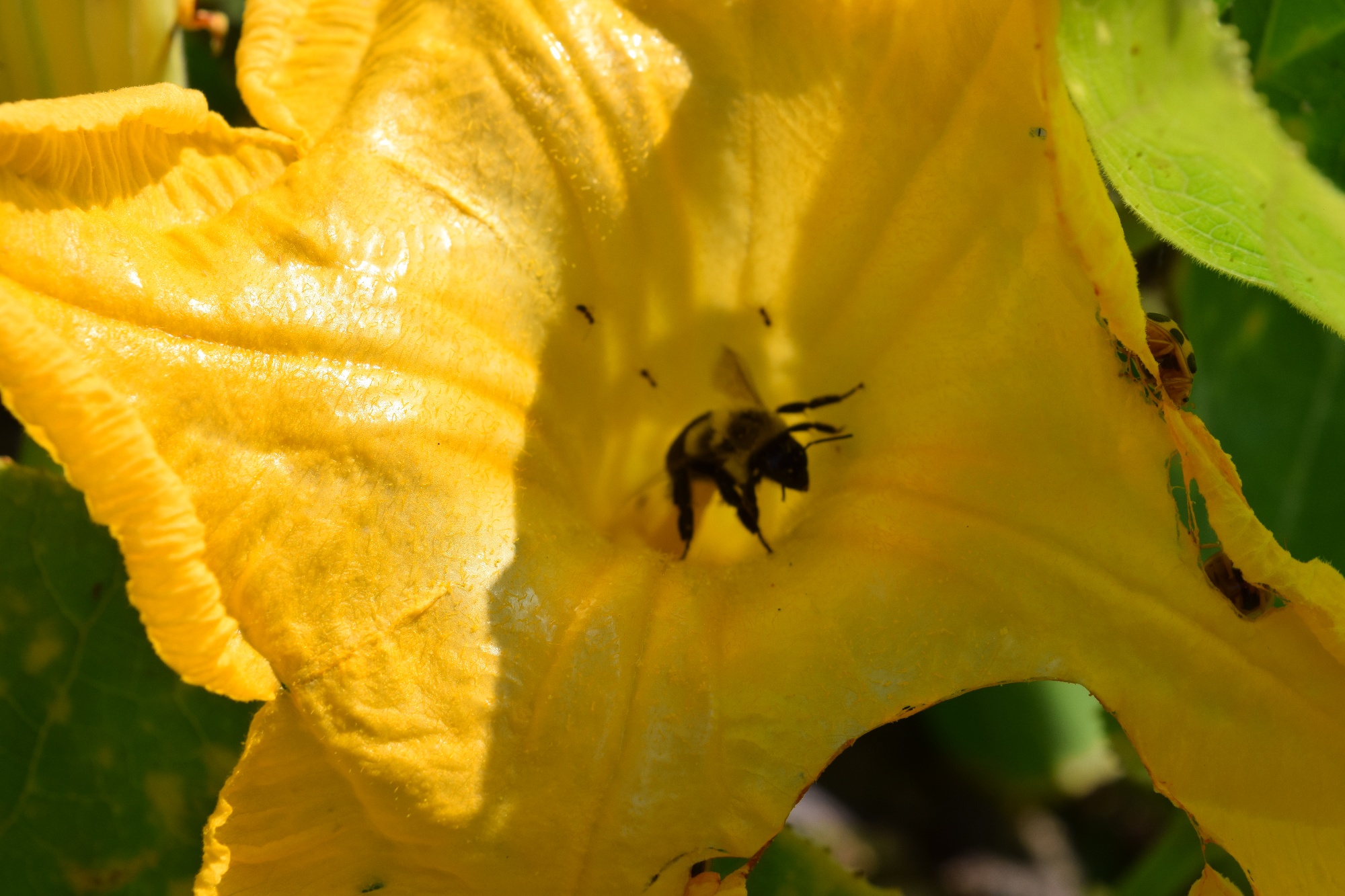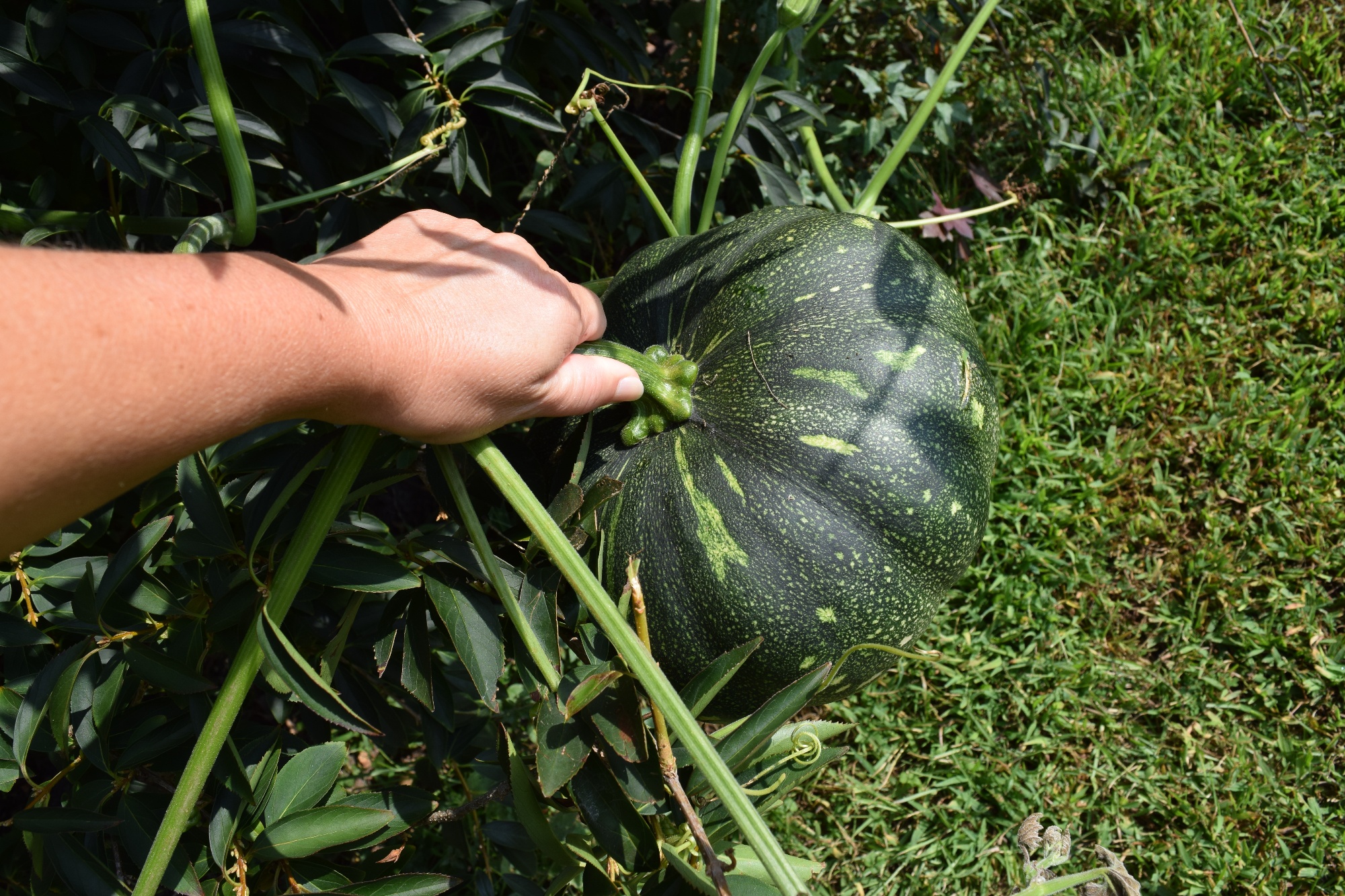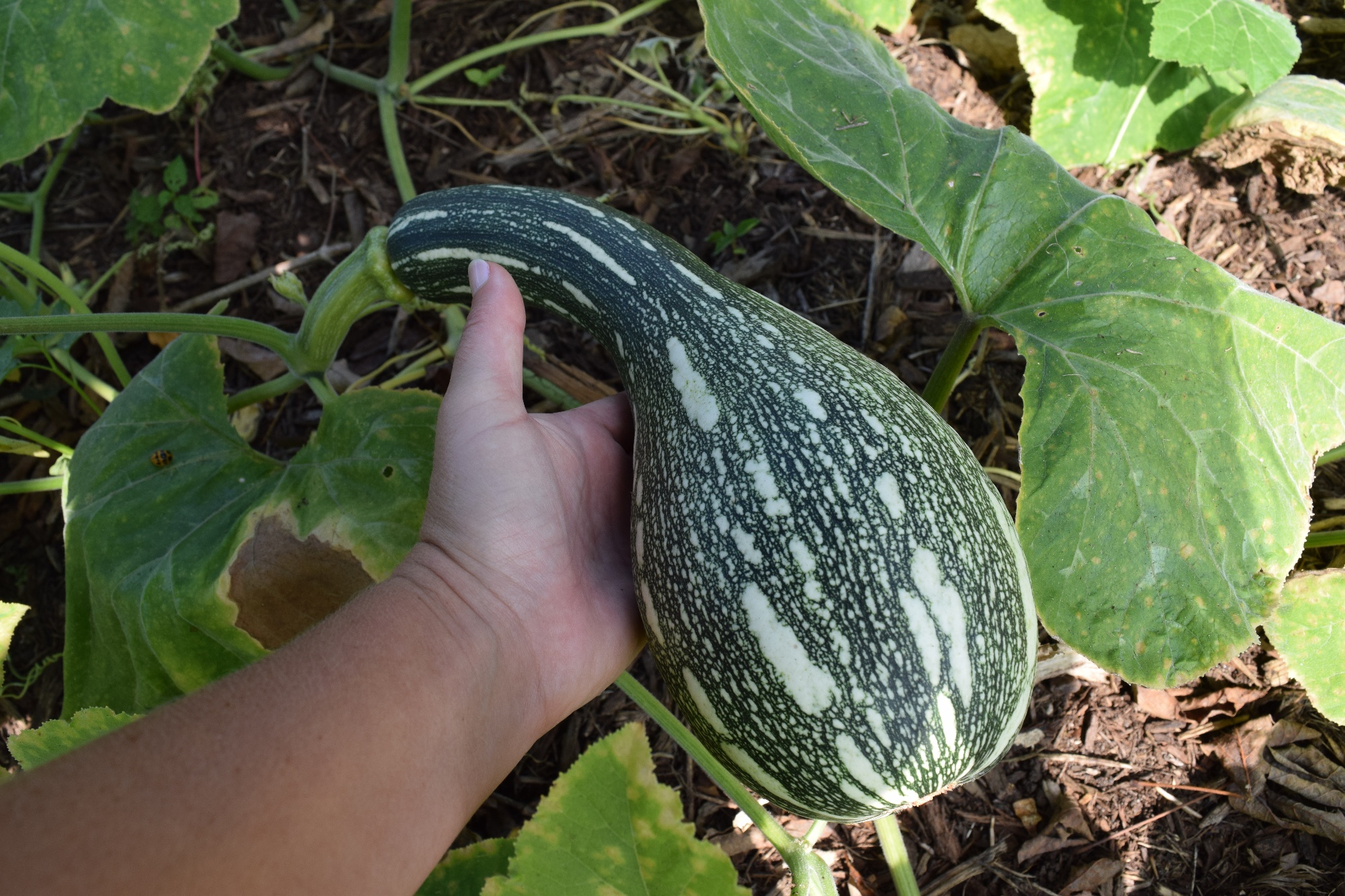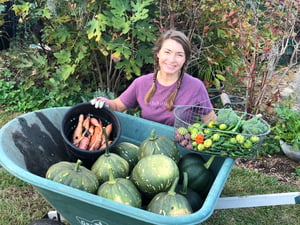Happy fall, y’all! We officially have longer nights and cooler temperatures and for gardeners in the southeast, it is time to get busy outside enjoying the change of seasons.
Since October is THE month for all things pumpkin, this month’s blog is all about sharing advice from my many years of experience so that you can have a successful harvest in the years to come.
Cushaw squash vines in the front foodscape.
It is fair to say that I have become totally infatuated with pumpkins, gourds, and squash. I suppose it’s been a long time coming, but this year I have really leaned into it, with vines growing all over my property. I am hoping to inspire you to fall in love with growing these gorgeous plants, too.
Autumn Decorations - Grow Your Own
Have you decorated for the season yet? I got a head start this year after a visit to the NC mountains where the pumpkins and gourds were irresistible! I justified this indulgence in the name of seed collecting. Though many of these don’t thrive in the Piedmont region where I live, I figured it would be worth a try to save seed and grow them next year.
Unique pumpkins and gourds are natural fall decorations.
Most importantly, consider using natural décor that will decompose in place of plastic stuff that ends up in a landfill. The fall season is all about celebrating the beauty of nature, so take advantage of all that your garden offers. Want to see what is growing in my garden? Take a virtual tour with this video:
Growing 'Pumpkins' in the Southeast
The trick to growing “cucurbits”, aka gourds, pumpkins, and squash is rich, well-drained soil, specifically Soil³! These plants thrive in Soil³ compost (now I use Veggie Mix) and will ultimately provide you with an enviable harvest! Last year I grew the Seminole pumpkin in straight Soil³ and harvested 52 delicious fruit!
Over the years I have discovered that in the hot, humid southeast climate it is best to wait to sow these seeds until mid-summer. July is ideal for seeding because they germinate quickly and generally only take 75-100 days to have mature fruit, which is well within our frost-free window. Simply mound 8-12” of Soil³, dig a hole 1-2” deep, and drop a seed in. Keep the area moist and fertilize with a natural fertilizer such as kelp once the plants have established true leaves.
Another noteworthy trick is to give the vines plenty of space, either horizontally as a ground cover or let them climb into trees and shrubs. Growing vertically allows the plants to have better airflow, which helps reduce powdered mildew. Note I say “reduce” not eliminate, as most of these plants will show signs of powdery mildew by early September. However, that does not result in fruitless vines.
Treating Powdery Mildew
What is powdery mildew? It is a fungal infection that inhibits the transfer of essential nutrients and water through-out a plant. It is rarely fatal but is unsightly and can spread if left unchecked. The common cause is a fungus called Erysiphales which thrives in humid climates like the southeast.
How can you combat powdery mildew? The simple way is to remove infected material, especially if you catch it early. However, a kitchen staple also offers an easy-to-use solution: apple cider vinegar. Studies have demonstrated that the fungus cannot thrive when in contact with low pH levels, and apple cider vinegar (acetic acid) is very low: 2-4 pH.
It is imperative to DILUTE the vinegar before applying in your garden! Simply mix 3 tablespoons of apple cider vinegar into 1 gallon of water and spray on any infected plant. Cover both the top and underside of the infected foliage to eliminate any spores that could lead to a future infection. Allow to air dry and reapply as needed over the fall season. Remember, most of the plants that get infected with powdery mildew are annuals (like zinnias and pumpkins) or are deciduous and will lose their leaves, so don’t fret too much!
Pollinators Love 'em
Have you ever noticed that bees love to sleep inside squash and pumpkin flowers? I was curious to learn more about who these bees are, and it turns out they are native to North America! Meet the pumpkin pollinator specialists: Peponapis, which in ancient Greek translates to ‘Pumpkin Bee.’
Meet the pumpkin bee that sleeps in squash flowers.
There are 13 species of Peponapis, all of whom are cucurbit specialists feeding on a variety of wild gourds, squash, cucumbers, melons, and pumpkins. Both male and female bees feed exclusively on cucurbit pollen and nectar.
These bees are slightly larger than a honeybee, covered in a dense pile of hair and are fast flying even in very cool conditions meaning they can visit many flowers in a short time. They also spend more time on individual flowers than most bees and their movements inside the flower results in more contact with the reproductive parts and increased transfer of pollen grains compared to other bees.
Peponapis bees emerge very early in the morning often before the sunrise and are busy pollinating pumpkin in the near darkness well before any other bees are active. The male bees roost communally inside the male flowers and emerge at dawn from their sleep covered in pollen which they then transport to the female flowers as they search for nectar. In fact, the male bees are more efficient at pollinating pumpkin crops than the females because of this habit.
What About the 'Bad' Bugs?
It’s true, not all insects are good. The dreaded squash vine borer (Melittia curcurbitae/ M. satyrinformis) is a major problem for summer squash and zucchini. The good news is Cucurbita moshata, or winter squash varieties, are naturally resistant to squash vine borers.
Since squash vine borers are a major problem here in the southeastern US, and nearly every gardener I talk to asks about them, it is an important topic to cover. First, let’s understand more about the insect, which is the larvae of a moth. The adult orange and black Sesiid moth are day-active and frequently mistaken for a wasp. It co-evolved with squash, as both the plant and the insect are native to North America. Though the adult is a pollinator, their habit of laying tiny copper-colored clusters of eggs on squash plants leads to their host plants demise.
Once the eggs hatch the larvae chew into stem and slowly eat the plant to death. When you notice wilting leaves the damage is done and there is little that can be done to save your crop. However, my favorite biological control, Bacillus thurigiensis (Bt), can help! Simply spray liquid Bt on your squash plants regularly and that will help eliminate the larvae.
Great Varieties for the Southeast
There are 18 different categories of squash, and some perform great in the south, while others struggle due to our high night temperatures and humidity levels. The best advice I can offer is to grow varieties that are resistant to squash vine borers, which includes winter squash selections that are not only tasty, but beautiful to decorate with through the autumn season.
My top three varieties this year are: Seminole Pumpkin, Cushaw Squash, and the new All-America Selections Winner ‘Goldilocks’.
Seminole Pumpkin
This is the variety that won my heart last year and is the motivation behind my new pumpkin obsession.
I was gifted these seed from the Florida Master Gardeners, and it kept me occupied through 2020 watching it grow and develop tons of fruit, and then coming up with creative recipes for the abundant harvest. Now I would never garden without this enormous, beautiful vine. Learn more here on my website.

Cushaw Squash
A new to me variety that has been totally unexpected! I thought I had sown Seminole pumpkins in my front yard patch, but as it turns out, and much to my delight, the Cushaw Squash is thriving instead.

This seed was also a gift from a fellow gardener and friend, Josie Walker. When she visited in the spring she said, “these get BIG” and she was not lying! Turns out the fruit, when mature, can reach 15 pounds each! You can also harvest them small and eat them like a summer squash. They are an excellent addition to ratatouille.
Goldilocks Squash
This All-America Selections Winner is a must grow!
With bright orange skin these acorn squash fruits are a beautiful addition to a fall cornucopia. They are also super delicious roasted or sautéed. Each plant produces about 10 fruit that weigh in at 1 pound each. I have been impressed with their vigor and resistance to powdery mildew. Looking forward to growing a lot more of these in the future!
Cooking With Your Harvest
If growing the fruit is the game, eating it is the trophy. Of all the crops I grow, pumpkins and squash reign as the most practical. They are filling, versatile, and long lasting when stored out of the elements.
So, what do I do with all these fruits? Thanks to lifestyle expert Martha Stewart, finding a creative and tasty recipe is easy. Here are a few of my favorite recipes.
Happy Autumn Everyone
Every season is an opportunity to experiment with new plants and ways to grow. Next time you order a “pumpkin spice” something, I hope you will be inspired to grow a few of your own next season and use this blog as a helpful guide.
Remember, Soil³ is the key to success for all your gardening needs, so be sure to order now!
Until next month, happy gardening,
Brie



Did this help you out? Have any questions for clarity? Leave a comment below!